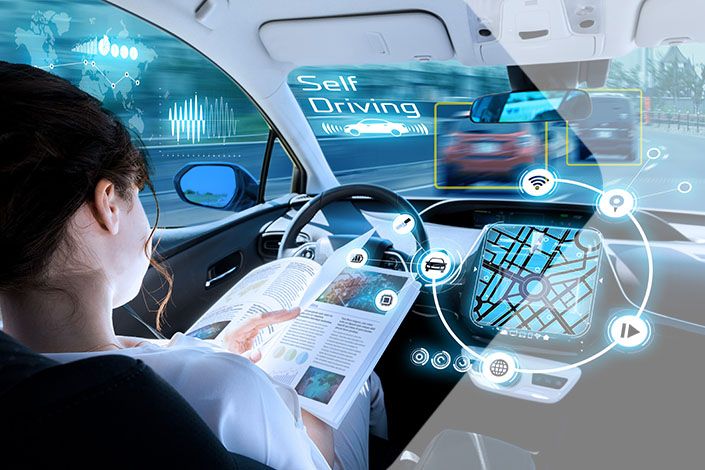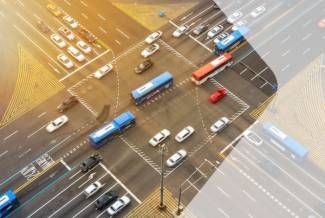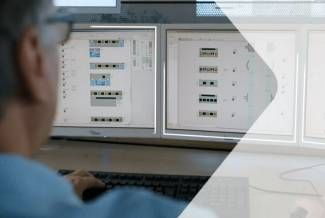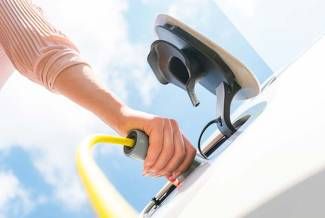Autonomous Driving: Ethics and Moral Dilemmas
In just a few years, semi-autonomous vehicles are expected to be routinely on the road. This also means that these vehicles will bear some of the driver's responsibility and will have to make decisions in precarious situations. Indeed, the driver only intervenes when the AI is overwhelmed. This also means that the car must be programmed accordingly – but what should the program look like? Whose safety needs to be prioritized?
On this page, you will get clear answers and learn all about autonomous driving, ethics and important moral aspects of fully automated driving.
Autonomous driving: Ethics, law and data protection
It is clear that autonomous driving offers many advantages. But where there is light, there is also shadow, and so questionable aspects must also be illuminated. These are primarily ethical and legal issues, as well as the question of data protection.
Autonomous driving and legal aspects
Ideally, autonomous vehicles are connected to the entire infrastructure and communicate with traffic light systems (e.g. green wave), other vehicles and intelligent traffic systems. However, in order for them to be perfectly integrated into the traffic network and for everything to function smoothly, traffic law must also be adapted. That is why many legal experts including the ethics committee are also discussing autonomous driving and the ethical problems that come with it.
At the moment, Germany only has a few test tracks and special permits with regard to autonomous driving. An adaptation of the legal framework must first be discussed and undertaken. The basis of the discussion is an international treaty of 1968 (the "Vienna Convention on Road Traffic"), which follows the basic idea that "every vehicle in motion must have a driver." (Art.8, para. 1).
Good to know: On March 30, 2017, the German Bundestag passed a law amending the Road Traffic Act to allow motor vehicles with highly and fully automated driving functions. According to Transport Minister Alexander Dobrindt, this gives Germany the most modern road traffic law in the world, putting drivers and AI on an equal legal footing.
In 2014, the Vienna Convention was supplemented by the United Nations. It now provides that technical vehicle systems are permitted that support the driver – for example, lane departure warning systems or automatic parking aids. However, the prerequisite for this is that the driver can switch off these functions or take back control at any time.
The ethics committee also identified the following points as essential. Autonomous vehicles are ethically acceptable ...
- ... if they help to reduce traffic accidents. The protection of human life is paramount.
- ... if they have a positive risk balance, i.e. cause fewer accidents than human drivers.
- ... if the protection of human life is given the highest priority. Damage to animals and property is acceptable if it prevents personal injury.
- ... if autonomous vehicles are programmed to drive defensively.
- ... if it is documented who was responsible for the driving task in which situation: human or computer.
- ... if the driver themselves can decide on the use and dissemination of his data (data sovereignty).
- ... if the use of self-learning systems does not undermine the rules of the Commission.
Furthermore, it is noted that both an offsetting of human lives and a qualification according to personal characteristics are inadmissible. With these points, the ethics committee states that autonomous driving does not transfer 100% of the driver's responsibility to the vehicle.

Autonomous driving and data protection
In addition to the moral and ethical aspects of autonomous driving, there are also concerns about data protection and privacy. After all, when cars drive autonomously, they collect a lot of data about their surroundings, traffic and passengers. This data is used to optimize the driving experience, but could theoretically be misused for other purposes such as advertising or surveillance.
The ethics committee speaks about this as follows:
"A complete networking and central control of all vehicles in the context of a digital transport infrastructure is ethically questionable if and to the extent that it cannot safely exclude risks of total surveillance of road users and manipulation of vehicle control."
It states:
"Vehicle owners or vehicle users decide in principle on the disclosure and use of their accruing vehicle data."
It is therefore important to ensure that this data is only used for legitimate purposes and that the privacy of passengers is protected. Autonomous vehicle developers must ensure that all data collected is anonymized and that passengers have full control over who has access to their data. This is how autonomous driving can be reconciled with data protection.
In addition, clear regulations and laws must be put in place regarding data protection in the context of autonomous vehicles. This will ensure that the many benefits of autonomous driving gain value and ethical questions can be answered positively.
Overall, autonomous driving offers many benefits in terms of road safety and efficiency. By ensuring that sufficient data protection is achieved, that these benefits are not achieved at the expense of moral principles or people's privacy, we can ensure that autonomous vehicles are a positive force for our society.

Autonomous Driving and Ethical issues
Autonomous driving presents us with many ethical questions, especially when it comes to what moral decisions an autonomous vehicle should make. For example, the main issue is the importance of human rights in the context of autonomous driving. Example: an autonomous vehicle must decide whether to protect a pedestrian or a vehicle occupant. Should the vehicle save the occupant or the pedestrian?
This question leads us directly to a discussion of human rights, autonomous driving, and morality. We have long been familiar with moral dilemmas from philosophy - for example, the trolley problem, in which a switchman must decide which and how many people to sacrifice in order to save other lives. These situations can be quite realistic in road traffic. And to illustrate this, here is an example:
Should people be put at risk to save other people's lives? And if so, which ones?
A car carrying three passengers needs to get to the hospital as quickly as possible. Due to the speed, a precarious situation arises in which it quickly becomes clear that the braking distance is too short. An evasive maneuver is only possible to the left or right.
- On the left is an elderly gentleman and a pregnant lady,
- on the right there is a column of cyclists.
Should the car swerve to the left or right, or accept a collision that endangers the vehicle occupants?
Recent studies, for example a Study by Audi (“SocAlty") or the Cambridge Study by MIT-Media-Lab, are trying to raise public awareness of what it means when machines make decisions on their own and decide about people's lives. A visit to the Moral Machine website shows that in some situations it is not so easy to make a decision.
Dilemmas like these rightly cause some people to be skeptical of autonomous vehicles. For example, in a Statista survey conducted in February 2021, a total of around 40 percent of all respondents said they did not trust autonomous cars. Around 36 percent of respondents said they would only relinquish control for parking.
The fact that, according to infas quo, more than one in three German drivers fears greater distraction from installed driving assistants and therefore less road safety also shows the attitude of Germans toward autonomous vehicles. Regarding this issue, Audi makes the following statement on its website:
"Mistrust of the unknown is not an insurmountable hurdle. The experts involved in the "SocAIty" study largely agree on this. Mistrust has always been present when new technologies have entered people's lives. Elevators, airplanes or trains have nevertheless found a place in our everyday lives."
Concrete solutions by SWARCO
The ethical advantages of autonomous driving
It can be seen that autonomous driving is certainly being discussed in general, but that truly fully autonomous level 5 driving, where there are only passengers, is not yet in focus. Yet 90% of all accidents are due to human error.
With autonomous vehicles, this problem would be solved to some extent: Since autonomous vehicles can better assess traffic and impairments such as those caused by drunk driving can be ruled out, traffic would become safer. In addition, the vehicles are able to communicate with intelligent traffic systems and prevent accidents or traffic jams.
An additional bonus is that the reduced stop-and-go operations also have less impact on the environment. The same applies to automatic parking outside the city - the tiresome search for a parking space would then be a thing of the past. In addition, automated driving systems should also enable individual mobility for people of advanced age in the future.
Learn more: Advantages and disadvantages of autonomous driving
Other topics related to
autonomous driving
Under the links you will find detailed information on the following specific topics:
Autonomous Driving & Safety
Conclusion: Autonomous driving and ethics are compatible
The issues of autonomous driving and ethics are not easy to reconcile and present us with some moral questions. Should autonomous vehicles always prioritize the lives of passengers or also protect other road users? How can we ensure that algorithms make fair and unbiased decisions? Clearly, some development is still needed. But despite these challenges, we remain optimistic that autonomous driving can create safer and more efficient mobility for all.
Last but not least: In summary, according to the Ethics Commission, the ethical concerns of autonomous vehicles can be offset if the many advantages remain and no legal obligation to use fully automated traffic systems is decided.
FAQ
Human life should always come first. Animal and property damage come second. So if autonomous driving serves to reduce traffic accidents, it is ethically justifiable.
Autonomous vehicles are able to reduce traffic jams and find more efficient traffic routes by communicating with the intelligent infrastructure. Automatic parking outside the city also saves long searches for a parking space. This can reduce CO2 emissions.
According to the "Vienna Convention on Road Traffic", responsibility for the vehicle lies solely with the person driving it. Who is to blame if an autonomous vehicle is involved in an accident causing personal injury has not yet been adequately clarified.

STAY INFORMED
GET OUR NEWSLETTER!
Subscribe to our ITS / Smart Mobility Newsletter and receive regular updates on trends, developments, solutions and events.





